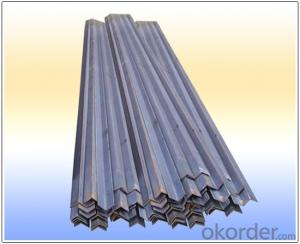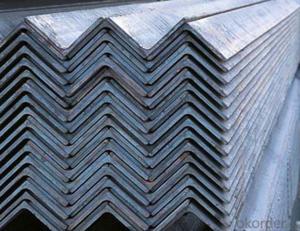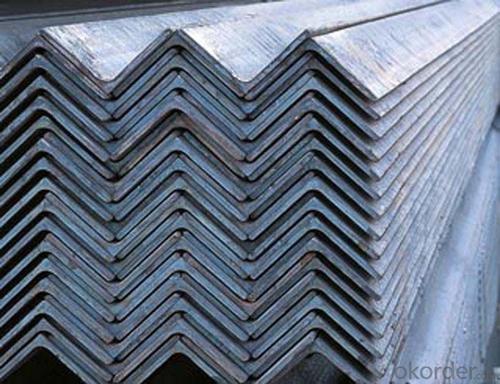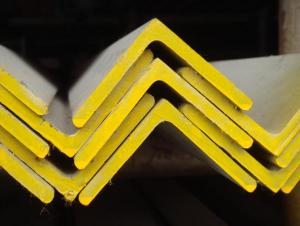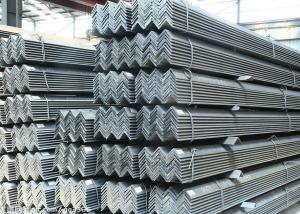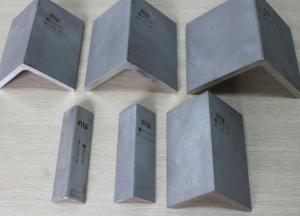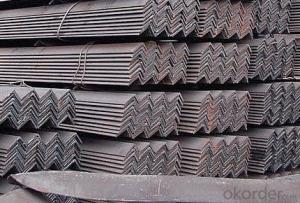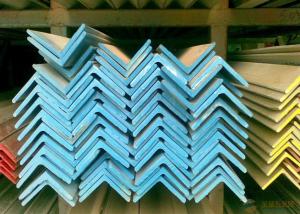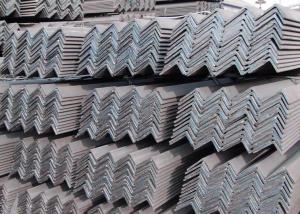stainless steel angle with customized size
- Loading Port:
- Qingdao
- Payment Terms:
- TT OR LC
- Min Order Qty:
- 10 m.t.
- Supply Capability:
- 5000 m.t./month
OKorder Service Pledge
Quality Product, Order Online Tracking, Timely Delivery
OKorder Financial Service
Credit Rating, Credit Services, Credit Purchasing
You Might Also Like
stainless steel angle
1.Grade:Q195-Q420
2.Surface:Bright,Polished,Turn smooth(Peeled),Brush,Mill,Pickled
3.Length:According to client's requirement ,it is from 3m to 6m
4.Size: Angle bar size from 10mm*10mm*2mm to to 400mm*400mm*16mm
5.Use:These products are widely supplied to areas of machine-made industry,chemical industry,spin,shipping industry,architecture,food industry,household products etc
6.ISO9001:2008
stainless steel angle | |||||||
| Size | Width (mm | Thicknessmm) | Density (kg/m) | Size | Width (mm | Thicknessmm) | Density (kg/m) |
| 20 | 20 | 3 | 0.889 | 80 | 80 | 7 | 8.525 |
| 20 | 20 | 4 | 1.145 | 80 | 80 | 8 | 9.658 |
| 25 | 25 | 3 | 1.124 | 80 | 80 | 10 | 11.874 |
| 25 | 25 | 4 | 1.459 | 90 | 90 | 6 | 8.35 |
| 30 | 30 | 3 | 1.373 | 90 | 90 | 7 | 9.656 |
| 30 | 30 | 4 | 1.786 | 90 | 90 | 8 | 10.946 |
| 35 | 35 | 3 | 1.578 | 90 | 90 | 10 | 13.476 |
| 35 | 35 | 4 | 2.072 | 90 | 90 | 12 | 15.94 |
| 35 | 35 | 5 | 2.551 | 100 | 100 | 6 | 9.366 |
| 40 | 40 | 3 | 1.852 | 100 | 100 | 7 | 10.83 |
| 40 | 40 | 4 | 2.422 | 100 | 100 | 8 | 10.276 |
| 40 | 40 | 5 | 1.976 | 100 | 100 | 10 | 15.12 |
| 44 | 44 | 3 | 2.002 | 100 | 100 | 12 | 17.898 |
| 44 | 44 | 4 | 2.638 | 100 | 100 | 14 | 20.611 |
| 38 | 38 | 3 | 1.719 | 100 | 100 | 16 | 23.257 |
| 38 | 38 | 4 | 2.261 | 110 | 110 | 7 | 11.928 |
| 48 | 48 | 3 | 2.19 | 110 | 110 | 8 | 13.532 |
| 48 | 48 | 4 | 2.889 | 110 | 110 | 10 | 16.69 |
| 48 | 48 | 5 | 3.572 | 110 | 110 | 12 | 19.782 |
| 50 | 50 | 3 | 2.332 | 110 | 110 | 14 | 22.809 |
| 50 | 50 | 4 | 3.059 | 125 | 125 | 8 | 15.504 |
| 50 | 50 | 5 | 3.77 | 125 | 125 | 10 | 19.133 |
| 50 | 50 | 6 | 4.465 | 125 | 125 | 12 | 22.692 |
| 56 | 56 | 3 | 2.624 | 125 | 125 | 14 | 26.193 |
| 56 | 56 | 4 | 3.446 | 140 | 140 | 10 | 21.488 |
| 56 | 56 | 5 | 4.251 | 140 | 140 | 12 | 25.522 |
| 56 | 56 | 6 | 6.568 | 140 | 140 | 14 | 29.49 |
| 63 | 63 | 4 | 3.907 | 140 | 140 | 16 | 33.393 |
| 63 | 63 | 5 | 4.822 | 160 | 160 | 10 | 24.724 |
| 63 | 63 | 6 | 5.721 | 160 | 160 | 12 | 29.391 |
| 63 | 63 | 8 | 7.469 | 160 | 160 | 14 | 33.987 |
| 63 | 63 | 10 | 9.151 | 160 | 160 | 16 | 38.518 |
| 70 | 70 | 4 | 4.372 | 180 | 180 | 12 | 33.159 |
| 70 | 70 | 5 | 5.397 | 180 | 180 | 14 | 35.383 |
| 70 | 70 | 6 | 6.406 | 180 | 180 | 16 | 43.452 |
| 70 | 70 | 7 | 7.398 | 180 | 180 | 18 | 48.634 |
| 70 | 70 | 8 | 8.373 | 200 | 200 | 14 | 42.894 |
| 75 | 75 | 5 | 5.818 | 200 | 200 | 16 | 48.56 |
| 75 | 75 | 6 | 6.905 | 200 | 200 | 18 | 54.501 |
| 75 | 75 | 7 | 7.976 | 200 | 200 | 20 | 60.056 |
| 75 | 75 | 8 | 9.03 | 200 | 200 | 22 | 71.168 |
| 75 | 75 | 10 | 11.089 | Length=6-12meters SS400 or Q235 | |||
| 80 | 80 | 5 | 6.211 | ||||
| 80 | 80 | 6 | 7.376 | ||||
- Q: Can stainless steel angle be used in aerospace applications?
- Yes, stainless steel angle can be used in aerospace applications. Stainless steel is known for its high strength, corrosion resistance, and durability, which are crucial properties required in aerospace components. Stainless steel angle can be used for structural purposes, such as supporting and reinforcing various aerospace structures, as well as for mounting and securing components in aircraft and spacecraft.
- Q: Can stainless steel angles be used in the construction of curtain walls?
- In the construction of curtain walls, stainless steel angles are indeed a viable option. Stainless steel, a versatile and long-lasting material, is commonly employed in diverse construction scenarios. This material presents numerous advantages, including remarkable strength, resistance to corrosion, and an appealing aesthetic. In the context of curtain walls, which are essentially vertical building envelope systems composed of glass and metal frames, stainless steel angles play a crucial role in providing both structural support and stability. These angles can be utilized to connect curtain wall panels, establish mullions, or enhance the overall framework. What's more, stainless steel angles can be tailored to meet specific design specifications and architectural preferences. Ultimately, due to their robustness, endurance, and capacity to withstand environmental factors, stainless steel angles are an ideal choice for curtain wall construction.
- Q: Consult 304 stainless steel angles. What tools are used for cutting and drilling?
- The corrosion resistance of the chemical composition of stainless steel with increased carbon content decreased, therefore, the carbon content of most stainless steel are relatively low, the maximum of no more than 1.2%, some steel Wc (carbon) or even less than 0.03% (such as 00Cr12). The main alloying element in stainless steel is Cr (chromium), which is corrosion resistant only when the Cr content reaches a certain value. Therefore, stainless steel in general Cr (chromium) content of at least 10.5%. Stainless steel also contains Ni, Ti, Mn, N, Nb, Mo, Si, Cu and other elements, stainless steel is not prone to corrosion, pitting corrosion or corrosion or wear. Stainless steel is one of the highest strength materials used in construction. Because stainless steel has good corrosion resistance, it enables structural components to permanently maintain the integrity of Engineering design.
- Q: What are the common grades of stainless steel used for angles?
- Angles are commonly made from two grades of stainless steel, namely 304 and 316. Grade 304 stainless steel is highly versatile and widely used due to its outstanding corrosion resistance, formability, and strength. On the other hand, grade 316 stainless steel is preferred in environments with harsh conditions or chemical exposure, as it offers superior corrosion resistance compared to grade 304. These two grades are popular options for angles because they are durable, visually appealing, and suitable for various structural and decorative applications.
- Q: What is the maximum load capacity for stainless steel angles?
- The maximum load capacity for stainless steel angles varies depending on the specific size, shape, and thickness of the angle.
- Q: Can stainless steel angles be used in bridge construction?
- Bridge construction can utilize stainless steel angles effectively. Stainless steel is a durable and versatile material that offers exceptional resistance to corrosion, impressive strength, and low maintenance requirements. These qualities make stainless steel angles appropriate for a wide range of applications, including bridges. In bridge construction, stainless steel angles find frequent use for different purposes. They can serve as reinforcement in concrete bridges, augmenting their strength and stability. Stainless steel angles can also fulfill structural needs by supporting beams and columns. Additionally, they contribute to the aesthetic appeal of bridges, adding a modern and sleek touch to their designs. One of the significant advantages of incorporating stainless steel angles into bridge construction is their resistance to corrosion. Bridges face various environmental conditions, including moisture, humidity, and chemicals, which can corrode traditional construction materials. However, stainless steel angles exhibit high resistance to corrosion, ensuring the long-term structural integrity of the bridge. Moreover, stainless steel angles offer a high strength-to-weight ratio, which benefits bridge construction. This means that stainless steel angles can provide the required strength while minimizing the weight of the bridge structure. This advantage becomes particularly important for large-scale bridges, where reducing weight can lead to cost savings and improved performance. In conclusion, stainless steel angles are a suitable choice for bridge construction due to their corrosion resistance, high strength, and aesthetic appeal. Their versatility and durability make them appropriate for various structural and reinforcement applications in bridges.
- Q: What are the different bending options for stainless steel angles?
- Some common bending options for stainless steel angles include cold bending, hot bending, and roll bending. Cold bending involves using a press brake to bend the angle to the desired angle or shape. Hot bending is done by heating the angle to a specific temperature and then bending it. Roll bending utilizes a machine with three rollers to gradually bend the angle into the desired shape.
- Q: What are the different types of stainless steel angles available for purchase?
- There are several different types of stainless steel angles available for purchase, each with their own unique properties and applications. 1. Austenitic Stainless Steel Angles: This is the most common type of stainless steel angle and is highly corrosion-resistant. It contains high levels of chromium and nickel, which give it excellent strength and durability. Austenitic stainless steel angles are often used in architectural and construction projects due to their aesthetic appeal and resistance to rust and staining. 2. Ferritic Stainless Steel Angles: Ferritic stainless steel angles have lower levels of chromium and nickel than austenitic stainless steel, making them less corrosion-resistant. However, they are still highly durable and are often used in applications where high temperatures and stress are factors. These angles are commonly found in automotive and industrial equipment. 3. Martensitic Stainless Steel Angles: Martensitic stainless steel angles have higher carbon content than other types, which gives them excellent hardness and strength. They are often used in applications that require high wear resistance, such as blades, cutting tools, and springs. However, they have lower corrosion resistance compared to austenitic and ferritic stainless steel angles. 4. Duplex Stainless Steel Angles: Duplex stainless steel angles are a combination of austenitic and ferritic stainless steel. They have high levels of chromium and nickel, providing excellent corrosion resistance. Duplex angles are known for their high strength and resistance to stress corrosion cracking, making them ideal for applications in the chemical, oil and gas, and marine industries. 5. Precipitation Hardening Stainless Steel Angles: Precipitation hardening stainless steel angles are heat treatable and offer a combination of high strength and corrosion resistance. They are often used in aerospace and high-performance applications that require both durability and the ability to withstand extreme conditions. When purchasing stainless steel angles, it is important to consider the specific requirements of your project or application. Factors such as corrosion resistance, strength, and durability should be taken into account to ensure you choose the most suitable type of stainless steel angle for your needs.
- Q: Are stainless steel angles resistant to chemicals and solvents?
- Yes, stainless steel angles are generally resistant to chemicals and solvents due to their corrosion-resistant properties.
- Q: Can stainless steel angles be used as structural supports?
- Indeed, structural supports can utilize stainless steel angles. Stainless steel, being a robust and long-lasting material, possesses the ability to endure substantial burdens and offer stability. In construction and engineering endeavors, stainless steel angles frequently serve as sources of structural support for beams, columns, and additional load-bearing components. Renowned for their impressive strength-to-weight ratio and resistance to corrosion, these angles prove suitable for both indoor and outdoor applications. Furthermore, their versatility is highlighted by the ease with which they can be fabricated and welded to meet precise design specifications, rendering them an adaptable selection for structural support systems.
Send your message to us
stainless steel angle with customized size
- Loading Port:
- Qingdao
- Payment Terms:
- TT OR LC
- Min Order Qty:
- 10 m.t.
- Supply Capability:
- 5000 m.t./month
OKorder Service Pledge
Quality Product, Order Online Tracking, Timely Delivery
OKorder Financial Service
Credit Rating, Credit Services, Credit Purchasing
Similar products
Hot products
Hot Searches
Related keywords
